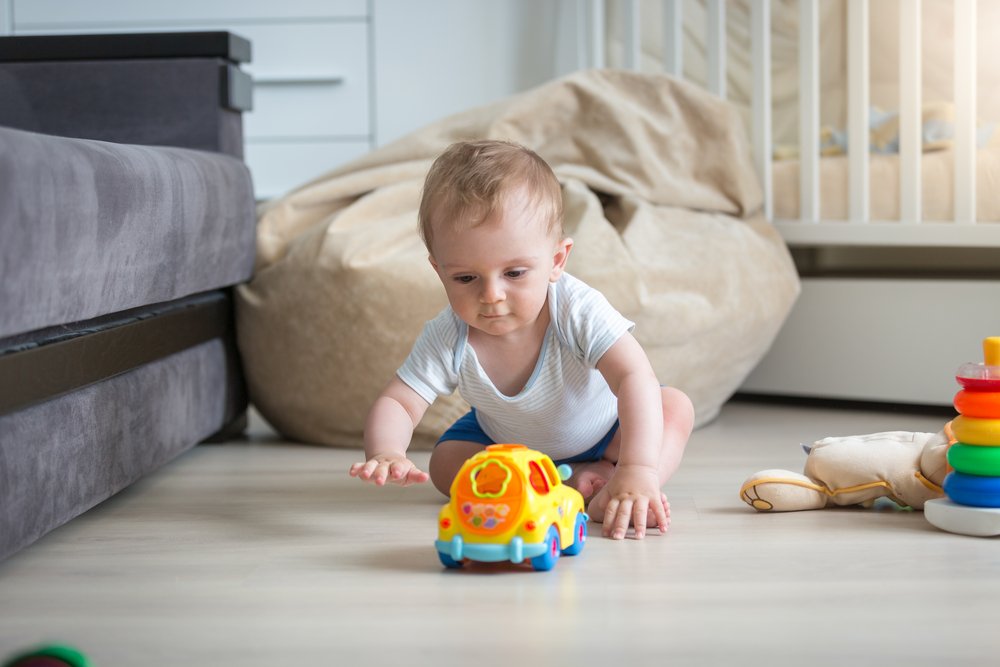Key points:
- Understand that crawling styles can vary, and your baby will choose what’s most rewarding for them.
- Prior to walking, babies need to practice balance and leg strength, and crawling helps develop these skills.
- Encourage reaching for toys placed just out of reach to promote weight shifting and balance.
- Use soft surfaces for tummy time and create opportunities for your baby to practice crawling-like movements.
We’ve previously discussed that crawling develops during a wide window of months and that your baby has a variety of styles they can adapt to. Keep in mind that your little one is not programmed to crawl. They’re mostly motivated to explore the world, experiment with different ways of moving, and will settle on the one that they feel is most rewarding.
So, while it might not look like a classic crawl, remember that sliding on the tummy, rolling, and bottom shuffling are still valid methods for moving around. The important part is that they coordinate both sides of their body and use each arm and leg equally. Even though most babies crawl, there’s a few babies that skip crawling altogether. If your baby is one of those cases, what can you do to still stimulate the variety of muscles and skills crawling requires?
Before your baby learns to walk, they’ll need to practice two very important things: balance and leg strength. By crawling your little one practices balance, coordination, and strengthens their arms, legs, and core muscles. They also learn the ability of shifting their body weight from side to side. If you think you have a non-crawler in your hands you can try practicing these exercises to foster these abilities.
- Reaching for attractive toys and noisy objects is an important exercise where your baby practices the weight shifting and balance they need. Make sure you give them plenty of opportunities to do this and keep challenging them by placing the toy a bit further every time.
- Place a couch cushion on the floor and help them explore it by placing toys on top of it. As they reach for the toys, they’ll strengthen their muscles and stabilize their hips to bear weight on both sides. This is essentially the movement of crawling. It will also help them get ready for later on pulling themselves up to a standing position.
- Place attractive toys to each side when playing seated. As you encourage them to twist and reach for the objects, they’ll learn they need to shift their weight over to one side to place both hands on the floor or object.
- Use a soft surface or carpet for tummy time. The soft fabric will motivate them to put their weight behind and press into their knees and hands.
- Practice tummy time on the floor with comfortable clothes or just in diapers. Make sure the room is not too cold for your baby and try playing belly down. The slick floor will give then an extra grip when moving arms and legs and will keep strengthening them. Belly crawling is not obligatory, but it is a method your baby might feel comfortable with. And, in most cases, belly crawling appears just prior to changing position to hands and knees.
- Sit on the floor with your child and place an attractive toy on your other side, encouraging them to crawl over you to reach it. You can slightly push their legs and trunk for them to reach the object. If they feel comfortable, try encouraging them to play with the toy while their belly rests on your legs. This way you’ll help them with some of the weight and still encourage them to reach while on a hands and knees position. They will work on their balance, weight shifting, and will strengthen their legs, arms, and core muscles.
- Get down on the floor and try it out with them. Your baby will feel more support once you see things from their point of view. Use smiles, make eye contact, and utter words of reassurance to encourage them to approach you.
Keep it up! The important thing is that your baby is able to explore their surroundings on their own and that they keep strengthening their body in preparation for walking and achieving other important milestones. If you feel your child is not moving normally, discuss your concerns with the pediatrician.








